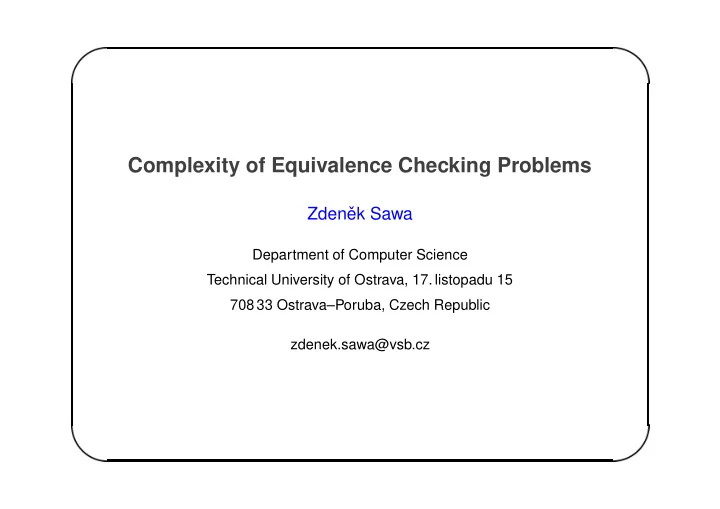

Complexity of Equivalence Checking Problems Zdenˇ ek Sawa Department of Computer Science Technical University of Ostrava, 17. listopadu 15 708 33 Ostrava–Poruba, Czech Republic zdenek.sawa@vsb.cz
� � � � � � � Examples of complicated systems: operating systems network communication protocols microprocessors parallel algorithms distributed algorithms traffic control systems . . .
� � Necessity of formal methods: testing and modeling explore some of possible behaviours formal methods allow to verify all possible behaviours – construction of rigorous mathematical proofs – may be automated (to some extend)
An example of a labelled transition system: a a b a a,b a a b
� � � � How a labelled transition system can be described: automata (finite state automata, pushdown automata, counter machines, . . . ) process algebras (CCS, CSP , -calculus) Petri nets
✂ ✁ ✆ ✄ ✆ � ☎ ✄ � � � Two main types of problems: Model checking I NSTANCE : a labelled transition system and a formula Q UESTION : Does satisfy ? Types of temporal logics: LTL, CTL, CTL , -calculus, . . . Equivalence checking I NSTANCE : two labelled transition systems Q UESTION : Is equivalent to ?
Bisimulation equivalence 2−nested simulation equivalence Ready simulation equivalence Possible−futures equivalence Ready trace equivalence Simulation equivalence Readiness equivalence Failure trace equivalence Failures equivalence Completed trace equivalence Trace equivalence
� � � Interesting questions: Where are the limits of automated verification ? What problems are decidable ? What is the computational complexity of decidable problems ?
� � � � Overview of own results: EXPTIME -hardness of equivalence checking of non-flat systems (CONCUR 2003) PTIME -hardness of equivalence checking of flat systems (SOFSEM 2001) DP -hardness of problems concerning one-counter automata (FOSSACS 2002) undecidability of deciding simulation equivalence for one-counter automata (SOFSEM ’99)
� ✁ ✂ ✄ EXPTIME-hardness of equivalence checking of non-flat systems: Parallel composition with hiding: EXPTIME -hard for every relation between bisimilarity and trace preorder (conjectured by A. Rabinovich [Rab97])
� � � Reactive linear bounded automata (RLBA): a b a a b a b b b a b a a a a a b a Q a new auxiliary model introduced in the proof considerably simplifies the proof allows simple generalization to other types of non-flat systems (labelled 1-safe Petri nets)
� � � � PTIME-hardness of equivalence checking of flat systems: Flat systems – states and transitions are given explicitly. The problem is PTIME -hard for every relation between bisimilarity and trace preorder. Implies that equivalence checking can not be efficiently parallelized – there is no efficient parallel algorithm unless NC PTIME .
� � A method for proving DP-hardness of verification problems concerning one-counter automata: One-counter automaton – a finite state automaton equipped with a counter One-counter net – can not test for zero, corresponds to a Petri net with at most one unbounded place General idea: OCL (One-Counter Logic) – a fragment of Presburger arithmetic, reductions from the deciding of the truth of formulas in OCL
� � � The method was used to show DP-hardness of: equivalence checking of one-counter nets for any relation between bisimilarity and simulation preorder deciding simulation equivalence and simulation preorder for a one-counter automaton and a finite state system (in both directions) model checking for a one-counter net and a formula from EF (a fragment of CTL)
Recommend
More recommend